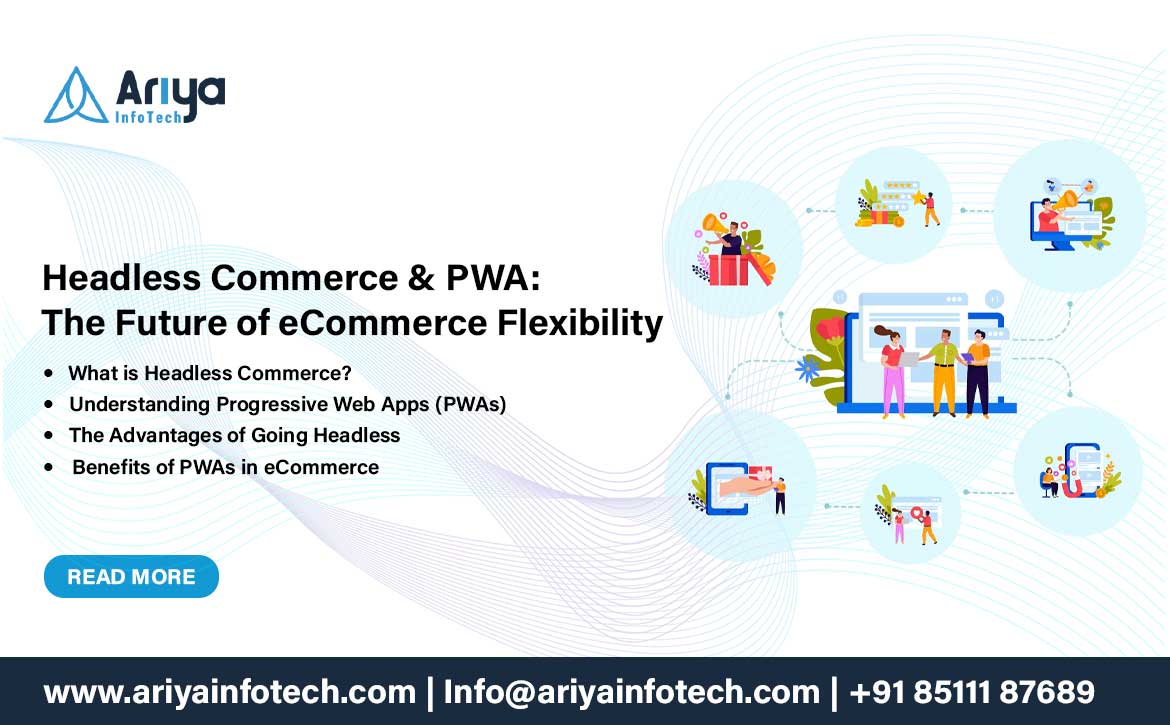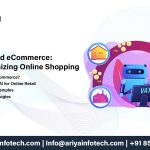Headless Commerce & PWA: The Future of eCommerce Flexibility

In 2025, the eCommerce landscape is evolving faster than ever, and businesses that fail to adapt risk being left behind. Among the key technologies driving this transformation are Headless Commerce and Progressive Web Apps (PWAs). Together, these innovations offer unprecedented flexibility, speed, and user experience for online stores. As consumer expectations grow and shopping behaviors shift across platforms, adopting headless and PWA solutions isn’t just forward-thinking—it’s essential.
In this comprehensive guide, we will explore
- What is Headless Commerce?
- Understanding Progressive Web Apps (PWAs)
- The Advantages of Going Headless
- Benefits of PWAs in eCommerce
- Technical Stack and Architecture
- Use Cases and Real-World Examples
- Challenges and Considerations
- Future Trends
- How Ariya InfoTech Helps Brands Build Future-Ready Stores
1. What is Headless Commerce?
Headless Commerce is an architectural approach that decouples the front-end presentation layer of an eCommerce platform from its back-end logic and data management systems. Traditional eCommerce platforms like Magento or Shopify manage both the frontend and backend in one monolithic system. With headless, these two layers are separated and communicate via APIs.
This allows businesses to use custom frontend technologies—such as React, Vue, Angular, or even native mobile apps—while still leveraging powerful backend platforms for product information, inventory, order processing, and customer data.
Key Concepts:
- Frontend (Head): The customer-facing interface (web, mobile, voice, IoT)
- Backend: Commerce engine (Shopify, Magento, BigCommerce, custom solutions)
- API Communication: REST or GraphQL used to exchange data between layers
2. Understanding Progressive Web Apps (PWAs)
PWAs are websites that use modern web capabilities to deliver an app-like experience on the web. They combine the best of web and mobile apps: fast loading, offline capabilities, and push notifications—without the need for app store installation.
Core Features of PWAs:
- Responsive design across all devices
- Works offline with service workers
- App-like navigation and interactions
- Installable on home screens
- Push notifications for re-engagement
PWAs use modern frameworks like ReactJS, VueJS, and Angular in conjunction with tools like Workbox and Webpack to deliver near-native mobile experiences.
3. The Advantages of Going Headless
a. Design Flexibility
Headless architecture gives developers and designers full control over the frontend experience. Unlike template-restricted platforms, you can create unique, brand-aligned UIs that match your creative vision and customer expectations.
b. Omnichannel Experience
With a headless approach, your backend can power multiple frontends: website, mobile apps, kiosks, POS systems, or even smartwatches. This omnichannel consistency is key to modern digital commerce.
c. Speed and Agility
Deploying changes to the frontend doesn’t affect the backend. Developers can iterate, test, and deploy new features faster and independently.
d. Developer-First Approach
Use modern JavaScript frameworks, component libraries, and continuous integration workflows without being tied to legacy systems.
4. Benefits of PWAs in eCommerce
a. Improved Performance
PWAs load significantly faster than traditional websites, especially on mobile devices. Faster pages lead to better SEO rankings and reduced bounce rates.
b. Better Mobile Experience
Mobile commerce is now over 65% of online traffic. PWAs deliver app-like performance and usability on the web without needing to build and maintain separate apps.
c. Offline Access
Thanks to service workers, PWAs can function even when offline. Users can browse cached pages, add products to carts, and complete purchases once the connection is restored.
d. Increased Engagement
With features like push notifications and home screen installation, PWAs help re-engage users and drive return visits.
5. Technical Stack and Architecture
Example Stack for Headless + PWA Store:
- Frontend: ReactJS, VueJS, Next.js, Nuxt.js
- Backend: Shopify Plus, Magento 2, BigCommerce, custom Node.js API
- API Layer: GraphQL or REST APIs for communication
- CMS Integration: Contentful, Strapi, Sanity, or custom headless CMS
- Caching & CDN: Varnish, Cloudflare, AWS CloudFront
- DevOps: CI/CD with GitHub Actions, Vercel, Netlify, Docker, Kubernetes
This modular architecture supports rapid development, easy scaling, and flexible deployments.
6. Use Cases and Real-World Examples
- Nike: Uses headless commerce for its global sites, delivering high performance and localized UX.
- Venus Fashion: Replaced a monolithic architecture with a PWA to increase speed by 50% and conversions by 75%.
- Alfred: Switched to headless Shopify + React frontend, improving time-to-market for marketing campaigns.
At Ariya InfoTech, we’ve implemented similar solutions for D2C and B2B brands across India, UAE, and the USA.
7. Challenges and Considerations
a. Development Cost
Building a custom frontend and integrating APIs requires more initial investment compared to a templated theme.
b. Technical Expertise
Headless and PWA development require experienced developers skilled in JavaScript frameworks and API architecture.
c. Maintenance
More flexibility comes with more responsibility. Teams need to manage multiple systems and integrations effectively.
8. Future Trends
- Composable Commerce: Mix and match best-of-breed services for a truly modular tech stack
- Edge Computing: Reducing latency and load times by processing data closer to users
- Voice Commerce: Headless backends powering Alexa, Siri, or Google Assistant-driven shopping
- AI Integration: Smart product recommendations, dynamic pricing, personalized UI/UX
- Web3 Payments: Integration with decentralized finance (DeFi) platforms and crypto wallets
9. How Ariya InfoTech Helps Brands Build Future-Ready Stores
At Ariya InfoTech, we help businesses embrace the future of digital commerce by:
- Designing headless frontends with cutting-edge JS frameworks
- Building ultra-fast PWAs for mobile-first engagement
- Integrating APIs across payment, shipping, inventory, and CRM systems
- Implementing SEO-friendly architecture for discoverability
- Managing CI/CD, cloud deployment, and monitoring infrastructure
Whether you’re a growing startup or an established brand, our eCommerce experts will guide you through every step of your headless transformation.
Final Thoughts
The combination of Headless Commerce and PWAs is the definitive path forward for modern eCommerce. As customers demand faster, more immersive, and consistent experiences across devices, brands need agile, scalable solutions. With the right strategy and expert development partner, your eCommerce store can become a high-performing, future-ready experience.
Ready to go headless? Let Ariya InfoTech guide your journey into the next era of digital commerce.


